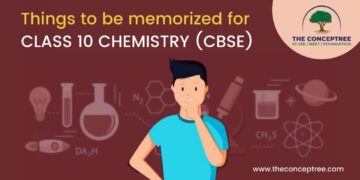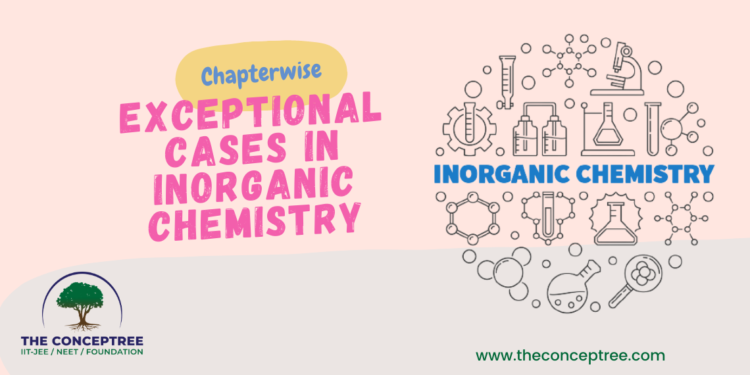CHAPTER: CHEMICAL BONDING
Exceptions of octet rule:
- Incomplete octet molecules or electron deficient molecules or hypovalent molecules Compounds in which octet is not complete in outer most orbit of the central atom. Examples. Halides of III A groups, BF3, AlCl3, BCl3, hydride of 13th group etc., Other examples: BeCl2 (4 electron), ZnCl2 (4 electron), Ga(CH3)3 (6 electron)
- Expansion of octet or electron efficient molecules or hypervalent molecules Compounds in which central electron has more than 8 electrons in the outermost orbits. Examples- PCl5, SF6, IF7, the central atom P, S and I contain 10, 12 and 14 electrons respectively.
- Pesudo inert gas configuration
Cations of transition metals, which contains 18 electrons in the outer most orbit.
Examples: Ga3+, Cu+, Ag+, Zn+2, Cd+2, Sn+4, Pb+4 etc., - Odd electron molecules
Central atom has an unpaired electron or odd number (7 electron, 11 electron etc.,) of electrons in their outermost shell.
Examples. NO, NO2, ClO2, ClO3 etc., - Transition metal ions.
Cr3+ [Ar]3d3 à (2, 8, 11)
Mn2+ [Ar]3d5 à (2, 8, 13)
Fe2+ [Ar]3d6 à (2, 8, 14) - Compounds of noble gases
Noble gases which have already completed their octets (or duplet in case of He.) should not form compounds. However, their compounds like XeF2, XeF6 & KrF2 etc., have been actually prepared.
Other exceptional cases:
- Case: AgBr, AgI are colored.
Reason: greater polarisation of Br– and I– ions - Case: Solid BeCl2 is sp3 hybridised polymeric solid but BeCl2(g) is sp hybridised
Reason: BeCl2 in gaseous state is linear and sp hybridised , herein, each Be atom it bonded to two chlorides and one empty valence orbital remains non-bonding but in solid state, it polymerizes, where Be gets bonded to four chlorides, so according to the concepts of hybridisation, for forming four covalent bonds, there needs four orbitals that participate in hybridisation, so four valence orbitals of Be atom (one s and three p ) undergoes hybridisation to give sp3 hybridised orbitals and forms polymeric BeCl2 molecule. - Case: Bond angle: NF3 < NH3 but PF3 >PH3
Reason: In NH3 and NF3 the angle between these molecules differ due to the electronegativity difference between them. The electronegativity of Nitrogen is more than that of H , therefore the bond cloud tries to attract to the nitrogen atom. Therefore, the whole electron cloud attracts to the central atom. Then each electron pair come closer to the each and due to this electron tries to repel each other. This leads to increase in the bond angle of NH3 but in NF3 the bond pairs attract to the Fluorine atom, (terminal atoms). The distance between electron pairs increase and hence, repulsion decreases. So, NF3 has smaller bond angle.
While the bond angle of PH3 is less than that of PF3. Both PH3 and PF3 are pyramidal in shape. Both have one lone pair on phosphorous. But PF3 has partial double bond character due to back π-donation of electrons from p orbitals of F atom to empty d orbitals of P. This results in large repulsion between P-F bonds and hence bond angle is large. There is no partial double bond character possible in PH3 (due to lack of p-orbitals in H).
The bond angle is more in PF3 due to lone pair-bond pair repulsion. As fluorine is smaller in size and more electronegative than hydrogen, the bond pair of electrons is towards F. - Case: Bond angle: Cl2O > H2O > F2O
Reason: In Case of Cl2O, delocalisation of lone pair (p) of electrons of oxygen to the vacant d-orbital of chlorine decreases the repulsion by lp and increases the repulsion between bp. The bond angle thus becomes very large (110.8∘).
In case of F2O, because of more electronegative F atom, bond pairs (bp) of electrons in O−F bond are shifted towards F, whereas in H2O, bond pair of electrons are drawn towards oxygen atom. So in F2O, the bond pairs (bp) being displaced away from the central atom has very little tendency to open the angle (i.e. bp – bp repulsion decreases and lp − lp repulsion closes the angle).
But in H2O, bp of electrons are closer to each other, and have more bp – bp repulsion than that in F2O, which opens the angle.
That is why, bond angle of F2O is less than that of H2O.
Hence, the bond angle order is Cl2 > H2O > F2O. - Case: C-F bond length: CH3F < CH2F2 < CHF3 < CF4
Reason: It can be explained by considering -I effect of F. As F has – I effect so it will pull electron density towards itself so C-F bond will be shorter. As number of F atom increases so amount of – I effect increases, consequently bond length decreases - Case: O-O bond length: H2O2 > F2O2
Reason: Hydrogen peroxide has open book structure as both the oxygen atoms are sp3 hybridized - Case: Bond angle of NO2 is 115 degree and of (NO2)– is 136 degree
Reason: in NO i.e. nitrite ion, N–atom has sp2 hybridisation; so, it adopts bent geometry, for NO, actual O-N-O bond angle is 115 °. It’s slightly deviated from expected 120° because of repulsion between the interacting bond pairs and lone pair of electrons.
CHAPTER: CLASSIFICATION OF ELEMENTS AND PERIODICITY IN PROPERTIES
EXCEPTIONS IN VARIATION OF ATOMIC RADIUS
In 3rd period
Predicted trend: Fe > Co > Ni
Actual trend: Fe » Co » Ni
Reason: Zeff ~ Screening effect à So atomic size will be almost same
In I, II and III transition series
Predicted trend: The atomic size will increase from top to bottom in a group.
Actual trend: 3d < 4d » 5d (Except III B or group 3)
*(III B obeys the general trend, i.e., Sc < Y < La)
For eg. In group 4 the atomic size varies as Ti < Zr » Hf.
Reason: The atomic size of Zr and Hf will be equal in size due to lanthanide contraction.
In group 13
Predicted trend: B < Al < Ga
Actual trend: B < Al » Ga
Reason: The atomic size of Al and Ga will be almost equal in size due to Transition contraction
EXCEPTIONS IN VARIATION OF IONISATION ENERGY
In s and p block elements (Across the period from left to right)
| Predicted trend | Actual trend | Reason |
| Be < B | Be > B | Due to penetration effect (s > p > d > f) |
| Mg < Al | Mg > Al | |
| Ca < Ga | Ca > Ga | |
| N < O | N > O | Due to extra stable half-filled electronic configuration of group 15 |
| P < S | P > S | |
| As < Se | As > Se |
In p block elements (Down the group)
| Predicted trend | Actual trend | Reason |
| Sn > Pb | Sn < Pb | Lanthanide contraction |
| Sb > Bi | Sb < Bi | |
| Te > Po | Te < Po |
In group 13
Predicted trend: I.E of B > Al > Ga > In > Tl
Actual trend: I.E of B > Tl > Ga > Al > In
Reason: Ga has higher IE than Al because of 3d contraction in Ga. Tl has higher IE than Ga because of Lanthanide contraction.
In group 4
Predicted trend: I.E of Hf < Zr
Actual trend: I.E of Hf > Zr
Reason: Lanthanide contraction.
EXCEPTIONS IN VARIATION OF ELECTRON AFFINITY
In s and p block elements (Across the period from left to right)
| Predicted trend | Actual trend | Reason |
| Li < Be | Li > Be | Due to penetration effect, s > p > d > f |
| Na < Mg | Na > Mg | |
| K < Ca | K > Ca | |
| C < N | C > N | Due to extra stable half filled electronic configuration of group 15 |
| Si < P | Si > P | |
| Ge < As | Ge > As | |
| F < Ne | F > Ne | Due to extra stable fully filled electronic configuration of group 18. |
| Cl < Ar | Cl > Ar | |
| Br < Kr | Br > Kr | |
| I < Xe | I > Xe |
In p block elements (Down the group)
| Predicted trend | Actual trend | Reason |
| B > Al | B < Al | Due to inter electronic repulsion in the elements of 2nd period elements due to their small size (only valid for elements of group 13 to 17) |
| C > Si | C < Si | |
| N > P | N < P | |
| O > S | O < S | |
| F > Cl | F < Cl |
EXCEPTIONS IN VARIATION OF ELECTRONEGATIVITY
In 0 group – the electronegativity is always zero, because the inert gas do not form molecule.
In group 1
Predicted trend: Cs > Fr
Actual trend: Cs » Fr
Reason: it is because from 55Cs to 87Fr only one shell increases but nuclear charge (No. of proton) increases by +32. So effect of nuclear charge balanced the effect of increase in number of shell.
In group 12
Predicted trend: Zn > Cd > Hg
Actual trend: Zn < Cd < Hg
Reason: Lanthanide contraction
In group 13
Predicted trend: B > Al > Ga > In > Tl
Actual trend: B > Tl > In > Ga > Al
Reason: Transition contraction
In group 14
Predicted trend: C > Si > Ge > Sn > Pb
Actual trend: C > Si > Ge » Sn » Pb
Reason: Poor screening effect of d and f electrons
In group 15
Predicted trend: Sb > Bi
Actual trend: Sb » Bi
Reason: Poor screening effect of f orbitals
EXCEPTIONS IN VARIATIONS OF DENSITY
In Group 1
Predicted trend: Na < K
Actual trend: Na > K
Reason: In K, 3d0 orbital is vacant, 3rd orbit has the capacity to hold 18e– but it has only 8e–. Due to empty orbitals atomic volumes increases and so density decreases.
In group 2
Predicted trend: Mg < Ca
Actual trend: Mg > Ca
Reason: In Ca, 3d0 orbital is vacant, 3rd orbit has the capacity to hold 18e– but it has only 8e–. Due to empty orbitals atomic volumes increases and so density decreases.
CHAPTER: s BLOCK ELEMENTS
Diagonal relationships:
Li shows similarities to Mg Due to similar size and e/m ratio
Be shows similarities to Al
Melting and boiling point variation
In group 2
Predicted trend: Be > Mg > Ca > Sr > Ba
Actual trend: Be > Ca > Sr > Ba > Mg
Reason: Presence of d- orbitals in the outer most shell of Ca, Sr and Ba forms stronger metallic bond.
Reaction with Nitrogen
General case: s block elements + N2 in air à No reaction
Exception: Li + N2 à Li3N
Formation of hydrides
General case: All alkaline earth metals combine with H2 to form hydrides
Exception: Be didn’t combine with H2 to form hydride
Nature of halide compounds
General case: All s block halides are ionic compounds mostly
Exception: Li halides are slightly covalent in nature (LiI is most covalent due to large anion)
Reason: Due to high polarising power of Li+ (Fajan’s rule)
Reducing property in solutions
Predicted trend: Li+ > Na+ > K+ > Rb+ > Cs+
Actual trend: Li+ > K+ » Rb+ > Cs+ > Na+
Solubility in water
Low solubility of LiF in water à Due to its high lattice enthalpy
Low solubility of CsI in water à due to smaller hydration enthalpy of its two ions
Anomalous behaviour of Li
- Increased covalent character which results in solubility in organic compounds.
- Harder and higher Melting point and boiling point than other alkali metals.
- LiCl is deliquescent and crystallises as hydrate (LiCl.2H2O), other alkali metal chlorides don’t
- LiHCO3 is not obtained in the solid form while all other elements form solid hydrogen carbonate.
- Li unlike other alkali metals don’t form ethynide on reaction with ethyne.
- LiNO3 gives Li2O on heating while others decompose.
- LiF and Li2O are much less soluble due to covalency.
Anomalous behaviour of Be
- Be largely forms covalent compounds due to high ionisation enthalpy and small size
- Exhibit coordination number not more than 4, because of the absence of d orbitals. But other elements of this group has coordination number upto 6
- BeCl2 has a chain structure in solid state whereas other don’t
- Unlike other members, oxides and hydroxides of Be are amphoteric.
CHAPTER: p BLOCK ELEMENTS
BORON FAMILY
Stability of +3 oxidation state: B3+ > Al3+ > Ga3+ > In3+ > Tl3+ à due to inert pair effect stability
Stability of +1 oxidation state: B+ < Al+ < Ga+ < In+ < Tl+
Lewis acid character: BX3 > AlX3 > GaX3 > InX3
BF3 < BCl3 < BBr3 < BI3 à Due to back bonding
Reaction with mineral acids:
2M + 6HCl à 2MCl3 + 3H2
All metals except B react with mineral acids as mentioned.
Anomalous behaviour of B:
B shows anomalous behaviour due to its small size, high nuclear charge, high electronegativity and non- availability of d – electrons.
- B is a typical non-metal when others are metals
- Allotropy is exhibited alone by boron
- It’s a bad conductors of electricity when others are good conductors.
- It forms only covalent compounds while others also form some ionic compounds.
- Hydroxides and oxides of B are acidic in nature whereas those of others are amphoteric and basic.
- Trihalides of B exist as monomers while others exist as dimers
- It exhibits a maximum covalence of 4 while others exhibit a maximum covalence of 6
- Concentrated HNO3 oxidises B to boric acid while others become passive specially Al and Ga
CARBON FAMILY
Exceptional cases in C family
PbBr4 and PbI4 do not exist due to the fact that Pb4+ is a strong oxidising agent while Br– and I– are strong reducing agents, hence Pb4+ can’t survive in the presence of Br– and I–
Catenation tendency: C >> Si > Ge » Sn >> Pb
Anomalous behaviour of Carbon:
- Carbon differs from the other members of group 14, because of its small size, high electronegativity, property of catenation and absence of d- orbitals.
- The melting point, boiling point, ionisation energy and electronegativity of C are very high as compared to the rest of the members.
- It has maximum tendency to show catenation as compared to the other members of the family.
- It has high tendency to form pp multiple bonds while others form p d bonds and that too to a lesser extent.
- CO2 is a gas while dioxides of other members are solids.
EXCEPTIONAL CASES LIST IN INORGANIC CHEMISTRY
CHAPTER: CLASSIFICATION OF ELEMENTS AND PERIODICITY IN PROPERTIES
EXCEPTIONS IN VARIATION OF ATOMIC RADIUS
In 3rd period
Predicted trend: Fe > Co > Ni
Actual trend: Fe » Co » Ni
Reason: Zeff ~ Screening effect à So atomic size will be almost same
In I, II and III transition series
Predicted trend: The atomic size will increase from top to bottom in a group.
Actual trend: 3d < 4d » 5d (Except III B or group 3)
*(III B obeys the general trend, i.e., Sc < Y < La)
For eg. In group 4 the atomic size varies as Ti < Zr » Hf.
Reason: The atomic size of Zr and Hf will be equal in size due to lanthanide contraction.
In group 13
Predicted trend: B < Al < Ga
Actual trend: B < Al » Ga
Reason: The atomic size of Al and Ga will be almost equal in size due to Transition contraction
EXCEPTIONS IN VARIATION OF IONISATION ENERGY
In s and p block elements (Across the period from left to right)
| Predicted trend | Actual trend | Reason |
| Be < B | Be > B | Due to penetration effect (s > p > d > f) |
| Mg < Al | Mg > Al | |
| Ca < Ga | Ca > Ga | |
| N < O | N > O | Due to extra stable half-filled electronic configuration of group 15 |
| P < S | P > S | |
| As < Se | As > Se |
In p block elements (Down the group)
| Predicted trend | Actual trend | Reason |
| Sn > Pb | Sn < Pb | Lanthanide contraction |
| Sb > Bi | Sb < Bi | |
| Te > Po | Te < Po |
In group 13
Predicted trend: I.E of B > Al > Ga > In > Tl
Actual trend: I.E of B > Tl > Ga > Al > In
Reason: Ga has higher IE than Al because of 3d contraction in Ga. Tl has higher IE than Ga because of Lanthanide contraction.
In group 4
Predicted trend: I.E of Hf < Zr
Actual trend: I.E of Hf > Zr
Reason: Lanthanide contraction.
EXCEPTIONS IN VARIATION OF ELECTRON AFFINITY
In s and p block elements (Across the period from left to right)
| Predicted trend | Actual trend | Reason |
| Li < Be | Li > Be | Due to penetration effect, s > p > d > f |
| Na < Mg | Na > Mg | |
| K < Ca | K > Ca | |
| C < N | C > N | Due to extra stable half filled electronic configuration of group 15 |
| Si < P | Si > P | |
| Ge < As | Ge > As | |
| F < Ne | F > Ne | Due to extra stable fully filled electronic configuration of group 18. |
| Cl < Ar | Cl > Ar | |
| Br < Kr | Br > Kr | |
| I < Xe | I > Xe |
In p block elements (Down the group)
| Predicted trend | Actual trend | Reason |
| B > Al | B < Al | Due to inter electronic repulsion in the elements of 2nd period elements due to their small size (only valid for elements of group 13 to 17) |
| C > Si | C < Si | |
| N > P | N < P | |
| O > S | O < S | |
| F > Cl | F < Cl |
EXCEPTIONS IN VARIATION OF ELECTRONEGATIVITY
In 0 group – the electronegativity is always zero, because the inert gas do not form molecule.
In group 1
Predicted trend: Cs > Fr
Actual trend: Cs » Fr
Reason: it is because from 55Cs to 87Fr only one shell increases but nuclear charge (No. of proton) increases by +32. So effect of nuclear charge balanced the effect of increase in number of shell.
In group 12
Predicted trend: Zn > Cd > Hg
Actual trend: Zn < Cd < Hg
Reason: Lanthanide contraction
In group 13
Predicted trend: B > Al > Ga > In > Tl
Actual trend: B > Tl > In > Ga > Al
Reason: Transition contraction
In group 14
Predicted trend: C > Si > Ge > Sn > Pb
Actual trend: C > Si > Ge » Sn » Pb
Reason: Poor screening effect of d and f electrons
In group 15
Predicted trend: Sb > Bi
Actual trend: Sb » Bi
Reason: Poor screening effect of f orbitals
EXCEPTIONS IN VARIATIONS OF DENSITY
In Group 1
Predicted trend: Na < K
Actual trend: Na > K
Reason: In K, 3d0 orbital is vacant, 3rd orbit has the capacity to hold 18e– but it has only 8e–. Due to empty orbitals atomic volumes increases and so density decreases.
In group 2
Predicted trend: Mg < Ca
Actual trend: Mg > Ca
Reason: In Ca, 3d0 orbital is vacant, 3rd orbit has the capacity to hold 18e– but it has only 8e–. Due to empty orbitals atomic volumes increases and so density decreases.
CHAPTER: s BLOCK ELEMENTS
Diagonal relationships:
Li shows similarities to Mg Due to similar size and e/m ratio
Be shows similarities to Al
Melting and boiling point variation
In group 2
Predicted trend: Be > Mg > Ca > Sr > Ba
Actual trend: Be > Ca > Sr > Ba > Mg
Reason: Presence of d- orbitals in the outer most shell of Ca, Sr and Ba forms stronger metallic bond.
Reaction with Nitrogen
General case: s block elements + N2 in air à No reaction
Exception: Li + N2 à Li3N
Formation of hydrides
General case: All alkaline earth metals combine with H2 to form hydrides
Exception: Be didn’t combine with H2 to form hydride
Nature of halide compounds
General case: All s block halides are ionic compounds mostly
Exception: Li halides are slightly covalent in nature (LiI is most covalent due to large anion)
Reason: Due to high polarising power of Li+ (Fajan’s rule)
Reducing property in solutions
Predicted trend: Li+ > Na+ > K+ > Rb+ > Cs+
Actual trend: Li+ > K+ » Rb+ > Cs+ > Na+
Solubility in water
Low solubility of LiF in water à Due to its high lattice enthalpy
Low solubility of CsI in water à due to smaller hydration enthalpy of its two ions
Anomalous behaviour of Li
- Increased covalent character which results in solubility in organic compounds.
- Harder and higher Melting point and boiling point than other alkali metals.
- LiCl is deliquescent and crystallises as hydrate (LiCl.2H2O), other alkali metal chlorides don’t
- LiHCO3 is not obtained in the solid form while all other elements form solid hydrogen carbonate.
- Li unlike other alkali metals don’t form ethynide on reaction with ethyne.
- LiNO3 gives Li2O on heating while others decompose.
- LiF and Li2O are much less soluble due to covalency.
Anomalous behaviour of Be
- Be largely forms covalent compounds due to high ionisation enthalpy and small size
- Exhibit coordination number not more than 4, because of the absence of d orbitals. But other elements of this group has coordination number upto 6
- BeCl2 has a chain structure in solid state whereas other don’t
- Unlike other members, oxides and hydroxides of Be are amphoteric.
CHAPTER: p BLOCK ELEMENTS
BORON FAMILY
Stability of +3 oxidation state: B3+ > Al3+ > Ga3+ > In3+ > Tl3+ à due to inert pair effect stability
Stability of +1 oxidation state: B+ < Al+ < Ga+ < In+ < Tl+
Lewis acid character: BX3 > AlX3 > GaX3 > InX3
BF3 < BCl3 < BBr3 < BI3 à Due to back bonding
Reaction with mineral acids:
2M + 6HCl à 2MCl3 + 3H2
All metals except B react with mineral acids as mentioned.
Anomalous behaviour of B:
B shows anomalous behaviour due to its small size, high nuclear charge, high electronegativity and non- availability of d – electrons.
- B is a typical non-metal when others are metals
- Allotropy is exhibited alone by boron
- It’s a bad conductors of electricity when others are good conductors.
- It forms only covalent compounds while others also form some ionic compounds.
- Hydroxides and oxides of B are acidic in nature whereas those of others are amphoteric and basic.
- Trihalides of B exist as monomers while others exist as dimers
- It exhibits a maximum covalence of 4 while others exhibit a maximum covalence of 6
- Concentrated HNO3 oxidises B to boric acid while others become passive specially Al and Ga
CARBON FAMILY
Exceptional cases in C family
PbBr4 and PbI4 do not exist due to the fact that Pb4+ is a strong oxidising agent while Br– and I– are strong reducing agents, hence Pb4+ can’t survive in the presence of Br– and I–
Catenation tendency: C >> Si > Ge » Sn >> Pb
Anomalous behaviour of Carbon:
- Carbon differs from the other members of group 14, because of its small size, high electronegativity, property of catenation and absence of d- orbitals.
- The melting point, boiling point, ionisation energy and electronegativity of C are very high as compared to the rest of the members.
- It has maximum tendency to show catenation as compared to the other members of the family.
- It has high tendency to form pp multiple bonds while others form p d bonds and that too to a lesser extent.
- CO2 is a gas while dioxides of other members are solids.
NITROGEN FAMILY
Melting point:
Predicted trend: Increases down the group
Actual trend: increases upto As then decreases upto Bi
Reason: The size of the element increases the tendency of the elements to form three covalent bond decreases (Inert pair effect). Thus weak forces of attraction lead to lower the melting point.
Stability of +3 oxidation state: N3+ < P3+ < As3+ < Sb3+ < Bi3+
Stability of +5 oxidation state: N5+ > P5+ > As5+ > Sb5+ > Bi5+ à due to inert pair effect
Anomalous behaviour of N
- Nitrogen differs from other members due to small size, high electronegativity, high ionisation enthalpy and non-availability of d orbitals.
- N2 has unique ability to form pp multiple bonds with itself and with other elements having small size and high electronegativity, thus N2 exist with high bond dissociation enthalpy.
- Due to absence of d orbital in valence shell, it cannot form dp bond as the others elements of the same group.
- N does not form NX5 due to absence of s orbitals.
OXYGEN FAMILY
Stability of -2 oxidation state decreases down the group, +4 oxidation state increases and of +6 oxidation state decreases down the group, due to inert pair effect.
(Exception case, Oxygen only shows -2 oxidation state except in OF2 = +2)
Anomalous behaviour of O
- Due to its small size and high electronegativity, the H bond exists in H2O but not in H2S
- Absence of d orbital limits its covalency to four but in practice it rarely exceeds 2
HALOGEN FAMILY
Anomalous behaviour of fluorine
- Due to its small size, high electronegativity, low F-F bond dissociation enthalpy and non-availability of f- orbital.
- E and Electronegativity and electrode potential are higher than expected.
- Most reactions of Fluorine are exothermic (due to small and strong bond formed with other elements)
- It forms only one oxo acid while others form a number of them
- HF is a liquid (due to H bonding) while other HX are gases
CHAPTER: d BLOCK ELEMENTS
The element with exceptional configuration are
Cr24[Ar] 3d54s1
Cu29[Ar] 3d104s1
Mo42[Kr] 4d55s1
Pd46[Kr] 4d105s0
Ag47[Kr] 4d105s1,
Pt78[Xe] 4f145d106s0
Some exceptional cases:
- Sc and Cr melting point and boiling point increases then Mn to Zn melting point and boiling point decreases.
- All transition elements except (Zn, Cd, Hg, Mn) display typical metallic properties, such as high tensile strength, high thermal and electrical conductivity.






































